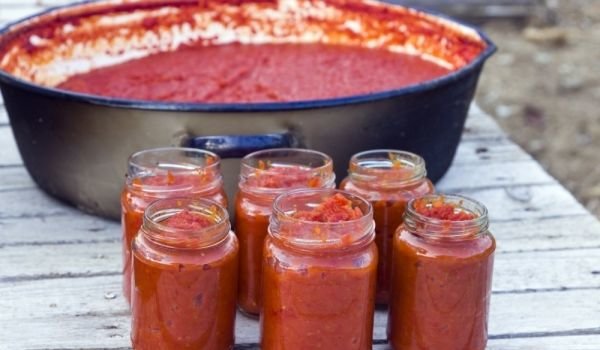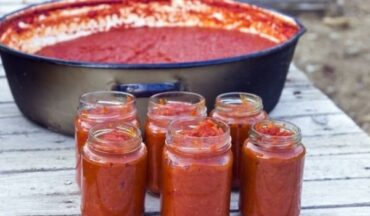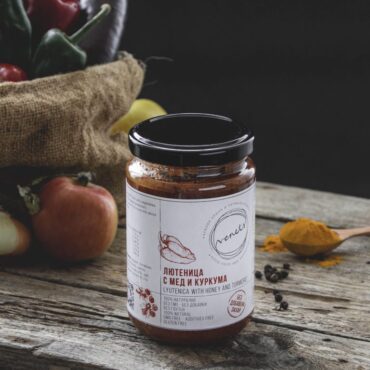Week 21
Vyara:
Hello, hello! Who is ready for the summer to be over? I don`t think anybody ever gave a positive answer to this question. As much as I would like to say that every season is beautiful on its own and that there are many things to be done in each of the them, the summer is the King of the year! There is something so nice about the angle under which the Sun shines, or the warm, endless summer nights… Yes, you know what I mean! So as much I don’t want to admit it, summer is ending. You can put the fire on, clean the jars and start making conserves for the winter! This week I will share with you a recipe for a traditional home-made preserve!
This is actually not my photo, it is from https://gotvach.bg/
Lutenitsa is a traditional staple in the Bulgarian cuisine! I don’t know a single Bulgarian who doesn’t like lutenitsa. Making lutenist is a sacred act, eating it brings pure joy! It is eaten during the winter months, with a piece of bread, on pancakes, on roasted potatoes, everything savory goes well with it! Every family has its own recipes, there are hundreds of brands on the market selling it Traditionally it is made with tomatoes, peppers, little bit of salt, pepper, oil, and sugar- this is the main recipe, however some people also put eggplant and cumin too. I advise you to make it only with the main ingredients, in order to taste the real thing.
Ingredients:
-tomatoes- 4kg;
– peppers- 5 kg;
-salt, pepper, oil and sugar to taste;
- The first and most important thing to do is to make the tomato sauce. You need to peel the tomatoes and take the seeds out. You can do this when you mash the tomatoes and then strain them through a sieve in order to separate the seeds from the fleshy part. It is important to note that, in order to make a kilo of sauce you need all of the 4 kg of tomatoes. The water will evaporate and the consistency should be thick.
- Roast the pepper (and the eggplant, which is optional) on a barbeque or fire (back in the days they used to roast the peppers on an open fire). Straight away put them in a pan and leave them to cool down, it will be easer to peel them afterwards. Remove the seeds as well!… the most tedious job, I know.
- The big moment of combining the two main ingredients has arrived! Do this in the biggest pot you can find. After that put it on the fire to boil and to thicken more. At this point you have to say goodbye to your arms, as you have to stir the lutenitsa constantly for 10-15mins. Put salt, pepper, sugar and the oil and leave it to boil for 5 more mins. If you can see the bottom of the pan while stiring the lutenitsa, then it is ready.
- Pour in hot jars, while still hot. Put the jars in a big pan with boiling water and boil for 5-10 mins.
- Enjoy!!
While I was researching for this post I came across a very interesting recipe. You can check it here:
Easy Lutenitsa Recipe: How To Make The Best Bulgarian Spread
OR if you think that you can`t make it by yourself and want to treat yourself with a something nice try the Venets lutenitsa, which is made with honey, turmeric and organic vegetables.
Lutenitsa with honey and curcuma from Venets https://venets.co
There are a few things that I want to share with you about seed savings and then I will pass the word to the other volunteers.
Contrary to popular belief, seed saving doesn’t start in autumn, when you collect the seeds. It starts when you pick what vegetables you want to grow in order to save their seed. The process continues when you sow, and take care of the plants. Then you have to decide, among them, which ones are the first, biggest and the best ones! You make a mental note and take care of those plants, you don`t just abandon them and leave them be, if they get too tall you need to provide them with support, water then and observe them. When the time comes you will literally pick the fruit of your labor.
Practical advice:
1.Saving the biggest plant has the biggest genetic information and the size means that it has more energy to make a nice vigorous flowering stem and seeds at the end of its life. That`s why it is important to choose the healthiest and biggest plant.
- Start with easy vegetables like: beans, peas, tomatoes, peppers. These are great for beginners. All of the above are self-pollinating (don`t need help, when it comes to pollination), the seeds are big and visible and a few plants are enough to produce a large amount of seeds.
- Know when you can harvest the seeds: garden crops can be divided into categories- wet or dry fruited. For crops that produce big, wet fruit/vegetables, the seeds are not always mature when the fruits are ready to eat. For example, big vegetables like cucumbers, pumpkins and eggplants are eaten when they are ripe, however in order to collect the seeds from those you need an overripe fruit. The so called dry fruited crops, like grains, lettuce and beans can be picked from the plant once seeds are dry and hard.
- Collecting the seeds: Collecting seeds from dry fruited crops is much easier than from the wet fruited crops. All you need to do is pick the pods or the flowers containing the seeds. It is a completely different story with the wet fruited, plants. When you see that the veggie is overripe, cut it and pick the seeds with a toothpick or a knife. In all cases make sure the seeds are completely dry before you store them.
- Storing seeds: The best place to store seeds is in a jar, in a cool, dark and dry place. Again, make sure the jars, the lids and the seed are completely dry before you store them.
This is all from me for this week! Stay tuned for more 😊




